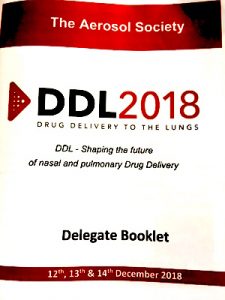 The annual Drug Delivery to the Lungs meeting once again experienced significant growth in attendance and sponsorship, as DDL 2018 drew more than 850 attendees and 110 exhibitors to the Edinburg International Conference Centre.
The annual Drug Delivery to the Lungs meeting once again experienced significant growth in attendance and sponsorship, as DDL 2018 drew more than 850 attendees and 110 exhibitors to the Edinburg International Conference Centre.
Many of the talks focused on the need for OINDP specialists to better deal with the complexity inherent in aerosol drug delivery and to develop a better understanding of how characteristics differ between types — whether those are types of particles, formulation, device, disease, or patient — in order to develop successful therapies. Speakers discussed various methods of modeling, analysis, and design that can lead to differentiated solutions.
In the first two sessions of the meeting, “Insights in Respiratory Medicine” and “Real World Challenges for Inhaled Medicines,” delegates heard speakers describe the challenges of selecting inhalers that have the potential to provide effective therapy, and that patients can and will use.
In some cases, speakers noted, the variety of inhalers available or in development is a problem. Jane Scullion and Bronwen Thompson (both members of the UK Inhaler Group) and Federico Lavorini of the University of Florence all stressed that the the proliferation of different devices over the years has done nothing to improve adherence or outcomes and urged delegates to think about standardization. The message was that the large number of different inhalers, with their different shapes, sizes, colors, procedures for use, etc., along with variations in the language used to describe the inhalers, can confuse patients and contribute to incorrect use and that industry should work harder to simplify inhalers.
That message got a certain amount of pushback during the Q&A time at the end of Scullion’s talk when Peter Villax of Hovione pointed out that the industry reacts to two different groups: the market and regulators. Obviously, he said, the market is not enough because nothing has changed in response to market demand, and he suggested that the addressing patient and clinician concerns to regulators would be more effective.


